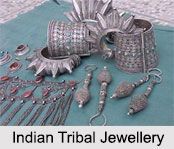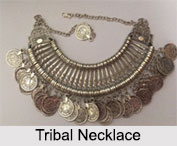 Indian Tribal Jewellery is a traditional form of Indian jewellery and is known for its rustic flavour. India is a country, blessed and endowed with a richtribal culture. The tribes of India have preserved the ancient crafts and arts of India with their ethnic pieces of jewellery. Ornaments used by the tribes stand out in a crowd because of its rustic and earthy flavour. They make jewellery from the indigenous items that are available locally. Moreover the jewellery they prepare exhibit their artistic skill in a profound manner. The appeal of the tribal jewellery is mainly due to its chunky and unrefined look.
Indian Tribal Jewellery is a traditional form of Indian jewellery and is known for its rustic flavour. India is a country, blessed and endowed with a richtribal culture. The tribes of India have preserved the ancient crafts and arts of India with their ethnic pieces of jewellery. Ornaments used by the tribes stand out in a crowd because of its rustic and earthy flavour. They make jewellery from the indigenous items that are available locally. Moreover the jewellery they prepare exhibit their artistic skill in a profound manner. The appeal of the tribal jewellery is mainly due to its chunky and unrefined look.Features of Indian Tribal Jewellery
Tribal Jewellery communicates a lot regarding the status of the individual who wears it, since these represent the socio-cultural traditions of those tribal groups. The materials which they commonly use to prepare the wonderful pieces of jewellery are wood, shells, bone, clay and some crude metals. Sometimes they also use hairs of animals in a painted form. The shapes which they use are basic and very close to the ethnic Indian art.
Indian Tribal Jewellery of Different Regions
 Various tribes in India use different types of jewellery to adorn themselves. Sometimes it is found that may be they are scantily clothed but they have ample jewellery on their bodies. Even tattoo is an attractive form of jewellery created by some tribal groups.
Various tribes in India use different types of jewellery to adorn themselves. Sometimes it is found that may be they are scantily clothed but they have ample jewellery on their bodies. Even tattoo is an attractive form of jewellery created by some tribal groups.The tribe of Bastar District in Madhya Pradesh uses a lot of grass, beads and cane to prepare their unique jewellery. Traditional ornaments made out of silver, wood, peacock feathers, glass, copperand wild flowers are also commonly used by the tribes of Bastar. Sometimes the women of the Bastar tribe are seen wearing necklaces made out of one rupee coin It portrays the culture of Bastar District.
Similarly, the Banjara Tribe is a group of nomadic people in Rajasthan. The use of colourful, heavy jewellery is very popular among them. They make ornaments and a variety of belts which are heavily embossed with metal-mesh, coins, beads, shells and chains.
The Tribes of Meghalaya like the Khasi, Jaintia and the Garo Tribes are known for their exclusive creation of jewellery. The Khasi and the Jaintia tribes mainly use thick red coral bead necklaces and the Garo on the other hand are identified with thread strung thin fluted stems of glass. The Bhutias of Sikkim use the traditional gold to make jewellery. Along with gold they also use metals like silver, zee stones, turquoiseand coral.
For more visit the link below: